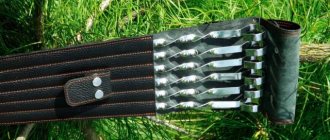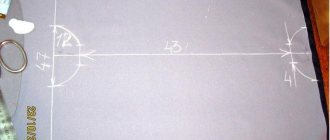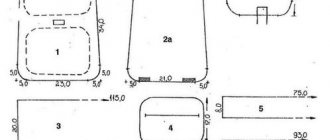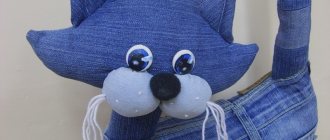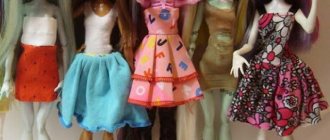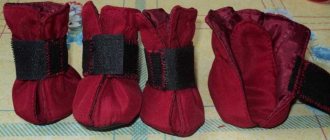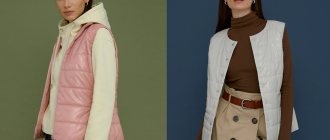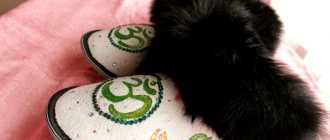A sundress is a women's dress without sleeves. Depending on the cut and the chosen fabric, it can be summer, home, urban, frivolous or business.
These clothes are appropriate to wear to a party or even to the office. This is a universal dress that will suit women with different body shapes, it is only important to choose the right style.
You can sew any of the sundress options yourself, and our tips and recommendations will help you with this.
A sundress is the most convenient item in a summer wardrobe
If we look at history, sundresses were once a part of a man's wardrobe. The women's sundress in Rus' appeared only in the 16th century (according to some sources - in the 17th century). There is no answer yet why it migrated to women’s wardrobes.
However, this type of clothing began to be worn not only by young ladies, but also by ladies of any class. Since then, this beautiful piece of clothing has undergone many changes, but it never goes out of fashion.
For the summer, every woman wants to have light, comfortable, airy clothes. The sundress is just what you need! You can make this item of clothing yourself by choosing the right color and elegant style.
Fashionable women with curvy figures will be able to sew a model with their own hands that would hide everything that they want to hide. A stylish new thing will be appropriate on the beach, while walking around the city, shopping, in a word, in any environment.
The creativity of beginners often begins with sewing a sundress. For beginning seamstresses, a sundress with a simple cut opens up space for further interesting experiments. Handicrafts make it possible to save on purchases, as well as endlessly diversify your wardrobe with stylish items.
Which material to choose? The most successful fabrics for this product are cotton, linen, silk, satin, chiffon.
The colors can be bright, with a large print or plain. Polka dots, stripes, and flowers are in fashion. The main requirement for fabric is ease of wear and comfort.
But the main dream of modern fashionistas is needlework without a pattern. For this reason, every woman is ready to sit down at the machine right now, just so as not to bother with patterns.
Every woman has this opportunity. The flared style is most suitable for hot weather. This universal option can be afforded by women of any build.
Thanks to the light tails, the sundress will delicately hide body imperfections and emphasize femininity. You can cut this model without a pattern.
Which fabric is better to choose
A sundress is an indispensable summer garment. When choosing a fabric, you should start from the style, since there are romantic models, for which flying, airy fabrics, for example, chiffon, are suitable. There are sports options. The best material here is denim. It should be viscose based, since cotton fabric is coarser.
Before choosing a particular material, you need to consider its characteristics:
Chintz. Usually has a bright pattern. You shouldn’t use it to make a sundress with a tight-fitting silhouette. The fabric is very thin, wrinkles easily and does not hold its shape very well. Chintz is best used for sewing loose-fitting items with numerous ruffles and folds.
Batiste is an ideal fabric for sewing clothes in a romantic style. Great for summer as it allows air to pass through well. The material is thin, translucent, pleasant to the touch. Drapes beautifully. The big advantage of cambric is that it practically does not wrinkle or deform after washing. Since the fabric looks simple, it should not be chosen for sewing an elegant or evening sundress.
Linen cools in hot weather and warms in cold weather. Since natural material does not dye easily, bleached fabric is used for sewing summer clothes. The natural material has a rigid structure, so it is suitable for cutting sundresses with a straight silhouette. The disadvantage of linen fabric without additives is high creasing. Plus, when cutting fabric, you must take into account that after washing linen shrinks significantly. This means that the pattern should be 1-2 sizes larger.
Staple. The material is light and thin and allows air to pass through freely. It is good to use for sewing floor-length models. Suitable for women with luxurious shapes, as it does not add extra volume to the figure.
Marquisette is a fabric for sewing luxurious evening and office sundresses. The fabric is distinguished by its weightlessness and silky sheen to its surface.
Chiffon is suitable for creating a romantic look. The fabric flows softly without creating creases or folds. Since the fabric is translucent, it needs a lining of a thicker material.
Silk. Natural fabric is expensive and suitable for sewing luxurious sundresses for a special occasion. Silk flows and pleasantly envelops the body. This fabric is very difficult to care for.
When sewing a summer sundress, you should give preference to natural fabrics. Satin, crepe, cambric are suitable. A dress made of lace will look very gentle. It is better not to buy synthetic fabrics such as nylon, polyester, spandex for sewing a sundress. They do not allow air to pass through well and are characterized by low hygroscopicity.
If it is difficult to find natural fabric, then you can buy a mixed fabric that uses synthetic and natural threads at the same time. But synthetics should be no more than 30%.
How to tailor a flared sundress
Buy light, flowy fabric. Find a tank top that fits you well.
Cut out the details of the product directly on the table using a T-shirt:
- First you need to cut the front: fold the T-shirt so that the side seams match.
- Place the purchased material, folded in half, carefully aligning the fold of the T-shirt and the fabric.
- Trace with chalk, leaving allowances of 1-1.5 cm.
- Having measured the required length and width, cut out the parts.
- Cut the back in the same way. At the same time, carefully round the bottom cut.
When cutting out the hem, pay attention to the nuances: the larger the bust size, the more rounded the bottom line should be. For the back, make the roundness smaller than for the shelf.
Without a pattern, you can sew a floor-length sundress. The principle of cutting and sewing is the same, only the length is completely different. It is recommended to make cuts on the sides.
Calculation of the required amount of material
The amount of material largely depends not only on the height and parameters of the woman’s figure, but on the style, length of the product, additional elements, for example, ruffles, and trim. If you buy little material, you will have to change the style; if you buy a lot, then this is an extra expense.
But it’s still better to take fabric with a small margin. It is important to consider the width of the canvas. The width should be no less than the girth of the figure at its widest point. If the width of the fabric is greater, then one length of the product will be enough, provided that the silhouette of the sundress is not very flared.
To accurately calculate the required amount of fabric, you need to consider the following:
- The width of the cut pieces, taking into account seam allowances.
- The presence of finishing elements - pockets, ruffles, bows, yokes and so on.
- The configuration of all elements and the possibility of their location on a canvas of a certain width.
- Total number of parts.
For example, we decided to sew a sundress with a straight, fitted cut. We take measurements and look at the volume at the widest point. We compare it with the width of the fabric. If the material is at least 10-15 cm larger, then you can buy one dress length. If the width of the canvas is smaller, then we buy two lengths.
This is the simplest calculation of the amount of fabric used in the studio. The example is also suitable for determining the required amount of material for sewing a children's sundress. To the resulting length of the product, it is necessary to add additional centimeters if the dress has ruffles, pockets and other additional elements.
In this video, the master explains how to correctly take measurements, calculate the amount of fabric and sew a two-tiered sundress that will suit any figure:
Beach options
Without thinking about the pattern, you can make an open-shouldered item yourself. It will take 2 hours of free time to make this style.
Measure your hip circumference, length and that's it. To highlight your waist, fold the fabric in half. From the top, make a slight narrowing towards the waist, then make a smooth transition to the main edge in the hip area.
How to sew:
- Connect the side sections, sew on a machine, and process with an overlocker.
- Hem the bottom, sew an elastic band on top. To do this, fold the top cut to the width of the elastic + allowance (1 cm).
- Sew, insert elastic.
For summer, you just need to sew so that you have time to make several models. For the next model, you need to measure the hip circumference and add the width of the wrap.
On the rectangle, on its two sides, cut the corners inward in the shape of a semicircle. Then draw the armhole line. To do this, process the semicircular cutouts with an overlocker. Then turn it inside out and sew, leaving space as for a drawstring. Make straps from bias tape, then insert them into the drawstring areas and sew the join.
You need to learn how to put on a ready-made outfit with straps: the left strap is put on the right shoulder, wrapped in linen. The right strap is then placed over the left shoulder.
This wrap style is incredibly easy to make and beach-friendly.
Rules for taking measurements and creating a pattern for a wrap dress
For beginning seamstresses, it is best to start sewing a dress with a classic style, since the patterns for such models are made simple and understandable. A classic among this style is the usual wrap dress.
Before you start work, you need to take measurements, including:
- OB (neck circumference);
- OB (hip circumference);
- OP (shoulder circumference);
- DL (shoulder length);
- BST (back height to waist);
- DI (product length);
- DR (sleeve length);
- distance from armhole to waist.
In order for the dimensions to be accurate, a number of conditions must be met:
- the person from whom measurements are taken must stand straight and free;
- measurements are taken on the body with a minimum of clothing (only underwear);
- An elastic band is tied around the waist of the person being measured;
- The centimeter when taking measurements should fit the body, since when the pattern is built, the necessary adjustments will be made.
Algorithm for creating a pattern for a simple model:
- The first thing you need to do is draw a large rectangle on a piece of paper.
- The neck of the product is drawn on the resulting geometric figure.
- Set aside the shoulder bevels. Which originate from the edge of the neck.
- After this, all the necessary cuts and slopes of the product are drawn.
After the pattern is created, you should double-check all the dimensions again, and then start cutting the fabric according to the existing blank.
Thanks to the basic pattern, you can create other models in the future, more original and stylish. To do this, simply adjust some details.
Empire style model
In order to present the advantages of your figure in the best light, you should create a sundress in the Empire style.
For this model you will need:
- The fabric is 2 meters long and 3 meters wide;
- finishing tape;
- bias tape.
Step by step:
- Fold the fabric in the middle, cut off a small corner on top. The corner should become a V-shaped cut. The middle of the canvas is the center of the front.
- Having prepared the canvas, you should stitch the seam allowances along the top edge and insert two straps from bias tape into them.
- Stitch the side seams while securing the ends of the straps.
- Fold the bottom edge inside out and machine stitch.
- Gather the top edge into a drapery, securing the finishing tape along the side seams. The bottom of the product can be made uneven, which is especially fashionable this season.
Story
A sleeveless dress with straps has always been considered Slavic. But research has proven that it borrowed its name and shape from the Turkic language, where such an outfit was called “sarapa”. Its first mention in Russian chronicles dates back to 1367. It was during that period that communication between peoples was the closest; the Slavs adopted not only product innovations, but also fashion trends - they began to shave their heads, grow “full” beards, and sew clothes similar to Turkic ones.
Already from Russia, sundresses spread throughout Europe, appeared in Scandinavian countries, and in the mid-19th century in America. The outfits differed in decoration and were made from various materials, but the pattern and style remained basic. The main criteria are the absence of sleeves, a simple cut, no darts, no fasteners, the main fabric is held on by straps. Modern fashion offers many variations of sundresses, but the real one must meet the listed requirements.
How to look stylish for a plump lady
For plus size women, the boho style is most suitable. It is this style that hides all the flaws and emphasizes the advantages of a curvaceous body.
To sew a sundress in this style, you will need a piece of light cotton fabric: 3 meters with a width of 150 cm, four buttons, thread, pins, a sewing machine. Having purchased fabric, first soak it so that the finished product does not “shrink”. Iron thoroughly.
Sewing procedure:
- Fold the fabric in half and cut it into two equal squares. Cut off the edge of each square to prevent the fabric from warping.
- Then work the sides of each square, baste, stitch.
- You will get squares measuring 145x145 cm. Place the first square in the shape of a rhombus. This will be a shelf.
- Using the finished pattern or T-shirt, make a neckline and armholes.
- The back is also cut out from a rhombus. Sew shoulder and side seams.
- Since we have already stitched all sides, no other processing is required.
- We decorate the product with buttons, cord, or just immediately put it on for a walk.
The boho style is very popular with women of all ages because it allows you to look young and perky. This model can also be sewn using the simplest pattern, simply by making bevels at the hem.
Boho styles are very different, but almost all of them are of the simplest cut.
Having made a trapezoid pattern with your dimensions once, you can sew different boho styles or simple summer sundresses using it.
Using the same pattern, sew a linen sundress, sewing on large pockets. Linen is the most suitable fabric for summer.
Second life of things: T-shirts and men's shirts
To sew a beautiful and stylish sundress for a girl with your own hands for the coming summer, you don’t have to buy new fabric.
For the creative process, you can use items from your own or a man’s wardrobe that are not worn and moved from shelf to shelf, purchasing in advance the necessary fittings and decorative ornaments.
Sew on straps
To sew a sundress with straps, you will need 1 m of light fabric with a width of 150 cm.
- Stepping back 10 cm from the edge of the fabric, cut off a strip for sewing the strap.
- By bending the sections inward, we stitch the strap.
- Next, fold the fabric in half and cut out two rectangles measuring 70x100 cm.
- We sew the side seams, retreating 20 cm from the top edge. This will be the armhole.
- We process the armhole, bend the bottom.
- We bend the edge of the upper part of the product by 15 mm and stitch it.
- We insert a strap into the resulting drawstring and do the fitting.
We will get a straight style; if you want to have a trapezoidal model, then you need to widen the bottom a little or insert a wedge.
Tips for choosing the perfect dress
There are a huge number of models and styles of linen dresses.
- There are basic dresses made of linen. These are straight models and A-line models. Such dresses can be complemented by some element, or maybe without them. There is a model that is in great demand - this bag dress. This dress is simple, but will become a wardrobe favorite in hot weather.
Basic dress
- Cut-off dresses also look very feminine and romantic. They can be fitted or loose. These dresses create a flirty and playful feel that will suit almost any girl.
- There is a style with a belt. This will highlight your thin waist. For delicacy, you should choose soft fabrics. The dress plays out completely differently.
Style with belt
- A shirtdress is a great office option. Color plays a role here. Convenience and comfort, severity and lightness.
- The wrap style is the personification of femininity. The best option for relaxation and city bustle. Models with flounces will add tenderness. Such elements will complement any look.
Five outfits in one evening
The most chic summer outfits can be made from scarves. Buy 2 silk scarves. The sides of the scarves can be of different lengths - 0.8 m, 1 m, 1.2 m. The longer the side of the scarf, the longer the sundress will be. In the photo, the length of the side of the scarf is one meter.
- Place a scarf close to you and mark the location of the cutout on your chest. Sew the scarves below this mark (the seam will be the middle of the front).
- Wrap the scarves at the sides, joining them at the back, and make a cutout at the back.
- Pin them along the mark, stitch them together (the seam is in the middle of the back).
- Fold in the seam allowances along the neckline and back of the garment and stitch.
- Sew a special elastic band in a zigzag along the dotted lines, pull the elastic band under the chest, adjusting its tension. Secure the ends of the elastic.
- Sew the finished straps to the corners of the scarves, crossing them on the back, and hem them under the neckline of the back of the sundress.
An open version of a sundress made from one scarf.
Choose a scarf with the longest side.
Decoration methods
The finished sundress can be left in its original form or decorated. It all depends on the chosen style of the product, the fabric used, and personal wishes. There are different types of decor that are suitable for finishing a sundress:
- decorative delay;
- ruffles, flounces, frills;
- embroidery, applique, drawing;
- beads, sequins, rhinestones.
You can choose a fabric with a ready-made image or show your own artistic abilities by painting the item with special acrylic paints. Sometimes decoration does not require additional steps.
It’s easy to add zest to the design with the help of an unusual cut or processing. Usually the straps, neckline, bottom hem or armholes of the item are highlighted. An interesting touch would be the combination of fabrics with different textures or colors.
Buying a sundress or sewing it yourself is an individual choice. A sleeveless dress is considered an elementary product that does not require high skill to perform.
All you need is the desire to create, a little time and the necessary minimum of materials. The result of your own handiwork will definitely please you and give you a desire to develop your handicraft skills.
Elegant models
How to sew a wide flying sundress? First, take a rectangular piece of fabric, fold it in half, and cut out a semicircle. Where the dotted line is shown on the drawing, stitch. Finish the edges of the product with the finished border.
You can quickly sew a tunic sundress from chiffon.
The chiton was worn by ancient Greek women and looked like goddesses. Today every woman will also look like a goddess!
A chiton can be made from two identical rectangular fabrics, 80-150 cm wide, and the length can be different. Chitons with a back length that is slightly longer than the front length look elegant.
Sew the side seams, leaving slits on the sides. In the shoulder area, fasten the sections using brooches or stitch like regular shoulder seams.
Such models are usually belted under the chest or at the waist. With this option, beautiful flowing coattails are formed along the entire length.
Using the trapezoid pattern, you can sew an elegant chiffon sundress.
Features of clothing for pregnant women
The use of natural materials, laconic cut, increased freedom in the waist area: the main “pillars” of the right sundress for ladies in an interesting position. To use the product at different stages of pregnancy, take a pattern taking into account the maximum protrusion of the abdomen.
In the first half of gestation, the sundress can be belted, achieving a comfortable and appropriate appearance. A pattern that meets the required parameters can be found ready-made or you can modify any basic model without an emphasis on the waist.
Linen jackets one pattern at a time
The secret is simple, using one pattern you can create not one, but two, three, or as many jackets as you like. This is a great item that will complement your look in cool weather.
Jacket pattern for any body type.
- Transfer the patterns to the material.
- Along the back, place the dart in the middle of the waist. Retreat 30 millimeters below, 20 millimeters above.
- Draw a stripe down the front to the hips.
- Down 50 millimeters.
- Make a dart at the waist.
- Set aside 30 millimeters to the right.
- Make a dart of the required depth.
- Make a lapel according to the model.
- Next, create a fold line for the lapel. Make patterns for the collar and sleeves.
- Next, connect everything along the seams, sew on the lining, sew on buttons, iron the lapel, and fit it.
- Sew the sleeves along the lines, trim the cuffs and attach.
That's all, you can create two different jackets using one pattern. This will increase your wardrobe and help you shine with different models.
Jacket pattern




